Swarovski AX Visio review: the world’s first smart wildlife binoculars
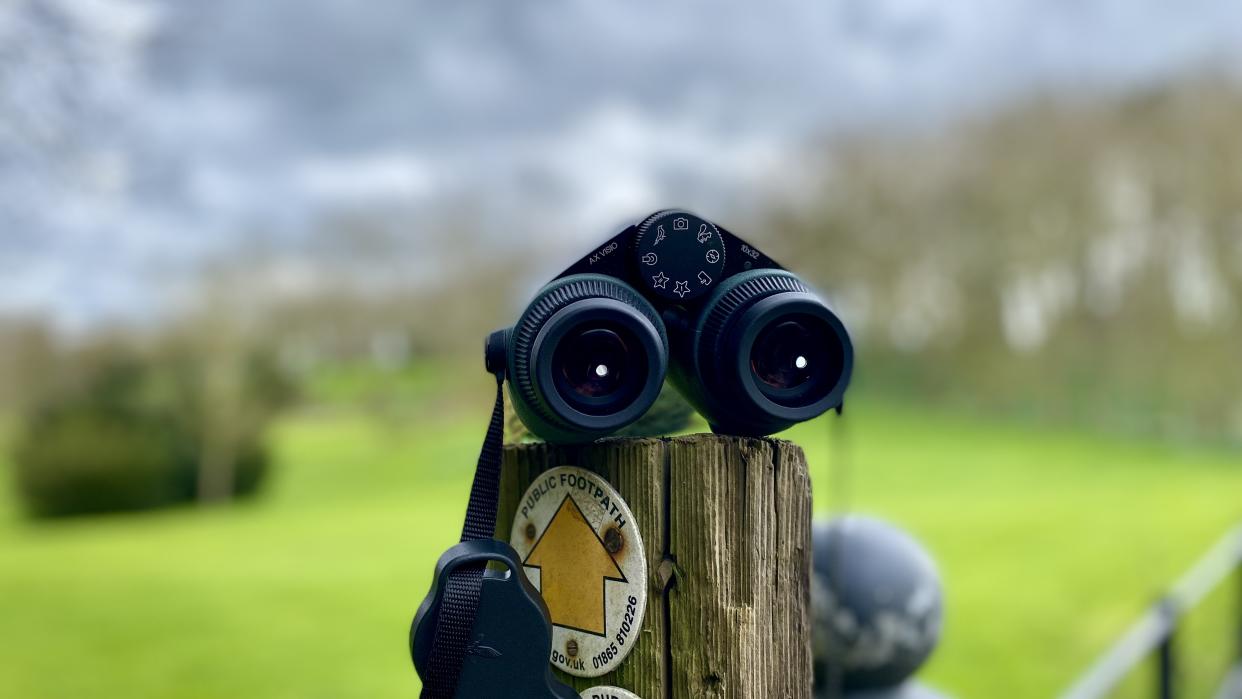
Welcome to our review of the Swarovski AX Visio, the world’s first smart binoculars with real-time bird and mammal identification.
Swarovski is usually the brand of choice among discerning bird and wildlife watchers, and for good reason – the quality of the company’s optics is on another level of precision while its attention to detail during the entire manufacturing process is at almost pedantic levels of care and scrutiny. Think Rolex or Patek Philippe and you get the picture.
Although extremely expensive, the AX Visio revolutionises the art of wildlife spotting and identification with its comprehensive onboard Merlin database of birds and mammals—a perfect fit for our guide to the best binoculars for birdwatching, no less.
But that’s not all. This high-end pair of binoculars can also take 13-megapixel stills and shoot 1080p video, display a live view of what you’re watching on an app, and even guide your companions to a subject in the viewfinder. In other words, it's a very clever piece of delectable kit.
Let’s look at the Swarovski AX Visio in more detail.
Swarovski AX Visio review
Swarovski AX Visio: price and availability
Are you sitting down? That's good because the Swarovski AX Visio costs a considerable £3,820 – £1,480 more than an equivalent pair of standard Swarovski NL Pure 10x42s (well, technically, the NL Pure 10x32s, but we haven't reviewed that). If you're shopping in the UK, you can snap up a pair directly from the Swarovski store or from Wex and Park Cameras.
Swarovski AX Visio review: design
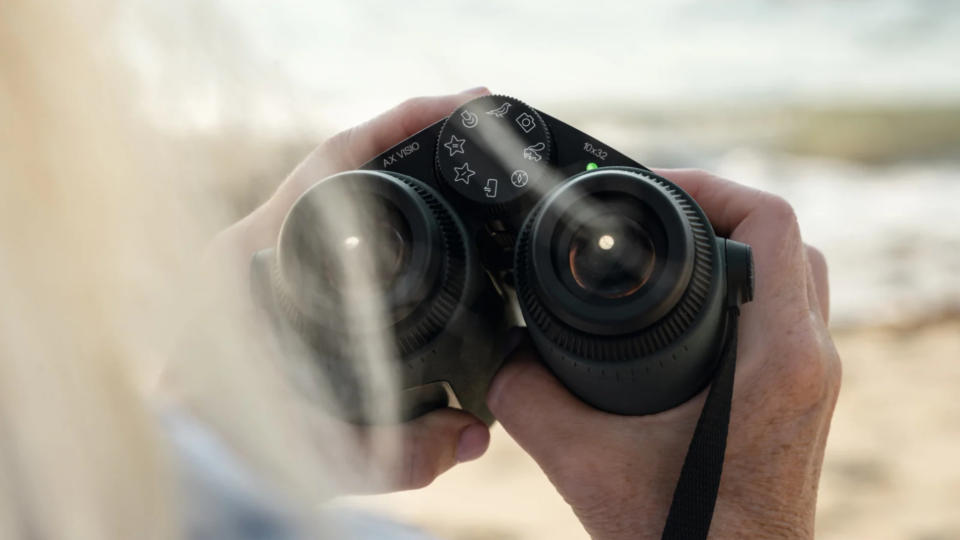
The AX Visio 10x32 is quite similar in design to Swarovski’s popular EL range of binoculars, except this model comes with an extra lens barrel in the form of a 265mm camera with a 13-megapixel sensor. At 1,090 grams, these bins are not especially light so you may need to find a branch or ledge to rest them on if viewing a subject for more than 30 seconds at a time. They are also quite wide (137mm) and maybe a bit too cumbersome for the smallest hands.
However, they do feel supremely comfortable, and Swarovski’s trademark dark green rubberised coating is extremely grippy, so chances of them slipping out of your hands are practically nil, even in a downpour with your hands covered in slippery mud. The stupendously smooth and perfectly sited focussing wheel, meanwhile, provides pinpoint accuracy with no faffing about.
If there are any negatives, it’s that the front and rear rubber lens protectors are a bit fiddly to put on, and only the eye lens protector is attached to the strap, so you’ll need somewhere safe to store the objective lens protector.
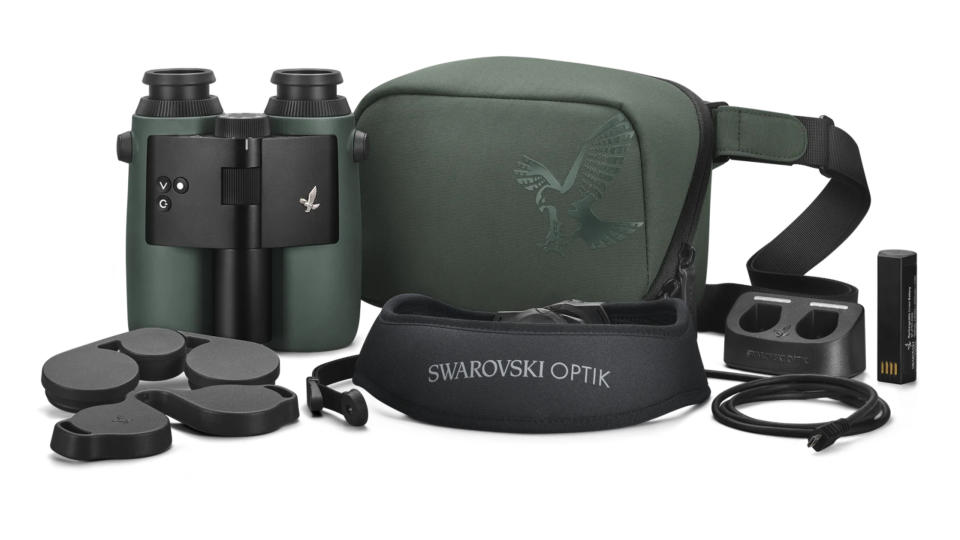
Since, the AX Visio’s smart features require a computer processor and media storage for the wildlife database, they are fitted with a removable rechargeable battery that’s super easy to swap out when far away from a charging source. That said, the supplied USB charging cradle is compatible with any decent USB power bank so you could have one battery charging while using another – no matter where you are. A spare AX Visio battery will set you back around £57 and should provide up to 15 hours of use.
The AX Visio comes with a weather-resistant side bag with integral shoulder strap, a bar of Swarovski soap, a brush and a lens-cleaning cloth.
Swarovski AX Visio review: optical features & performance
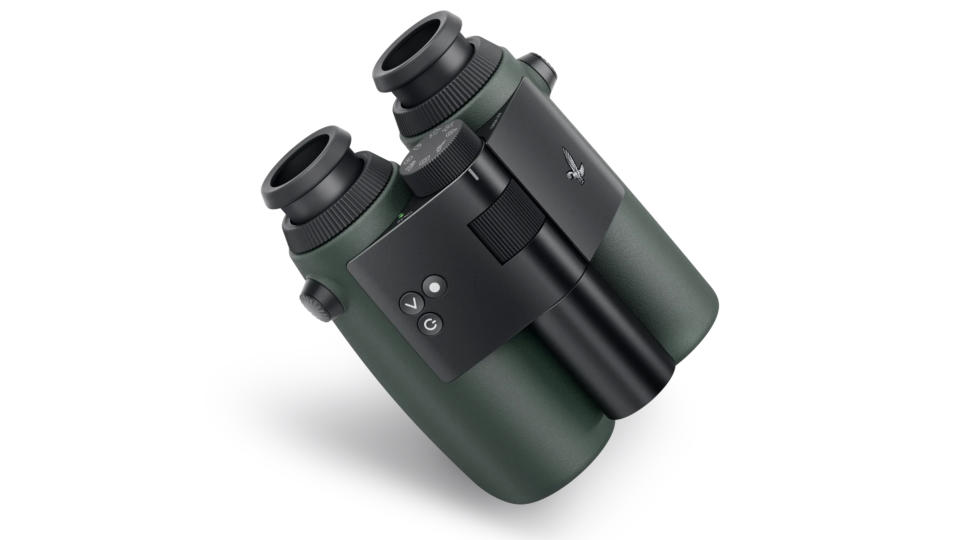
As a standard pair of binoculars, the AX Visio 10x32 is a sterling performer that produces wow-factor imagery. From the moment you untwist the notched eye cups and pop your peepers against them, you’re presented with a crystal-clear image right to the very edge with indiscernible chromatic aberration and no blurred edges. Likewise, brightness is phenomenal, even in low light.
These bins use Swarovision technology which basically means they were made to Swarovski’s highest standard of lens technology with optimised coatings and a flattened field of view that makes subjects literally pop out at you, almost like a cardboard cutout. Colour rendition is sensational and you will come to appreciate this when viewing birdlife in full plumage.
The AX Visio is equipped with 10x magnification which is the optimum magnification for excellent brightness, steady viewing and better-focussed image taking. It’s the perfect focal range for most users since anything higher will likely cause excessive image shake when holding them for long periods. The 32mm diameter front objective lenses, meanwhile, provide a very decent field of view of around 120m in width at 1000m without adding too much weight and size to the front end.
These binoculars also feature independent diopter adjustment so you can adjust the focus of each lens to one eye at a time. The result is focus so pin-sharp that you can see every detail of the subject as if it’s standing five feet away.
No question, when it comes to optical quality, Swarovski is almost in a league of its own. You really need to look through a pair to appreciate just how much better they are than most of the competition.
Swarovski AX Visio review: smart features & performance
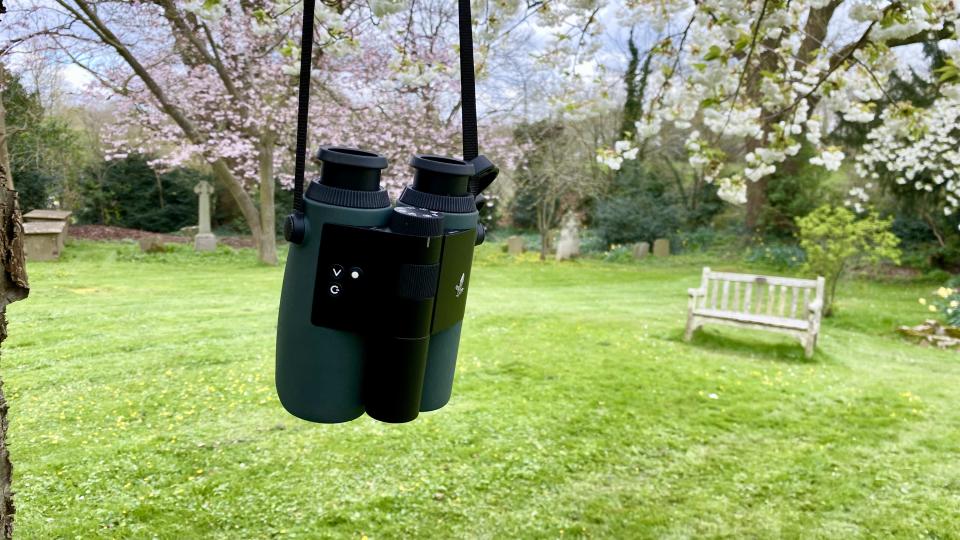
The Swarovski AX Visio is not so much designed for experienced ornithologists as well-heeled twitchers who would normally carry around a field guide of different bird species and look up each bird when seen. This system throws the field guide into the hedgerow and integrates Merlin’s phenomenally comprehensive bird ID database into the AX Visio. The system also uses GPS to provide accurate location and more reliable matching of species.
Given that these binoculars are equipped with an onboard microprocessor, they do take up to 20 seconds to boot up after pressing the ‘on’ button. One small problem with this is that birds rarely stand still for very long so you can be sure there will be some frustrating moments when you spot an unusual species of bird and by the time the bins have booted up, it’s flown away. Nevertheless, in most instances – especially with waterfowl – this won’t be too much of an issue. Besides, the bins can remain in an ’on' state for up to 5 minutes or, if you have a spare battery to hand, in ‘always on’ mode.
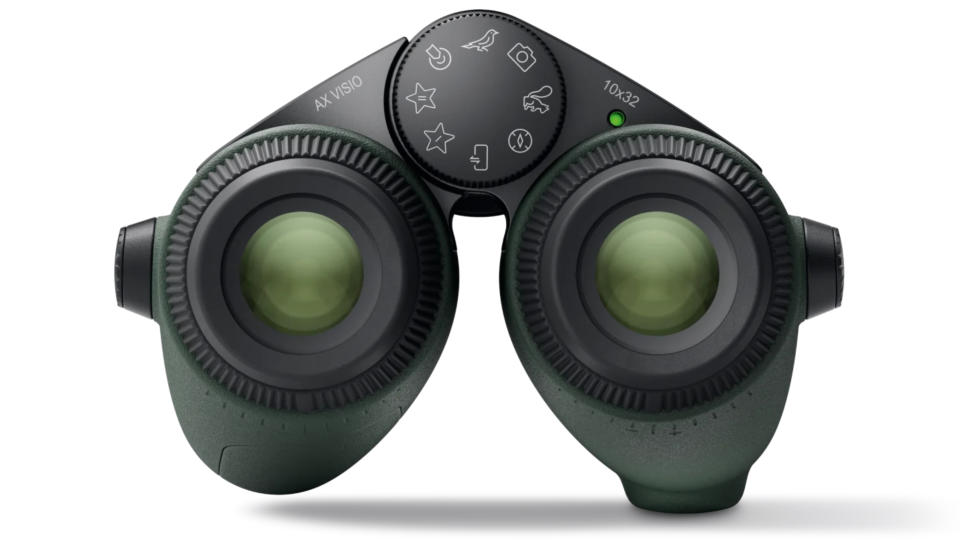
The AX Visio comes with five main ‘smart’ functions and you can’t miss the dial selector for them because it’s right in front of you on a big knurled thumb wheel. Let’s start with the ‘Identify’ mode for bird spotting. Turn the dial to the bird symbol and place the avian subject of your choice in the red circular reticle. Now press the raised circle button on the top right of the interface and, voila, up pops the name of the bird. It’s as simple as that.
I should add that there are two sizes of reticle in the viewfinder – one large and one small so use the V icon button to select the best reticle size so the subject fills the circle. I made this mistake when viewing a beautiful Red-tailed Kite flying some distance away, and the on-board bird ID database couldn’t identify it until I chose a smaller reticle. But, rather cleverly, the system did manage to identify a wood pigeon in mid-flight.
Naturally, you will need a good, clear sight of the bird for accurate identification, and this could be an issue if you’re in the woods and the bird is half obscured by branches. Mind, I was impressed when it gave an accurate description of a Eurasian Blue Tit that was half obscured by my bird feeder.
Mode two is devoted to mammal identification, but it’s not as comprehensive as the bird database, even though it quickly spotted and named the grey squirrel destroying one of my bird feeders.
One great thing about these binoculars is that they also allow for open-source development to further enhance their scope with more species, like butterflies and dragonflies. Simply use the app to assign the two star-shaped icons to butterflies and dragonflies, and you’re good to go. Expect many more mammals and insects to populate the database in the not-too-distant future.
The third mode is basically a compass, and it is very accurate too. Simply set the dial to compass mode and your position is shown in one-degree increments. If you’re more of an off-piste adventurer, this mode could be a lifesaver. Moving over to ‘Live View’, this mode allows a companion to see an acceptably sharp image of what you’re looking at via the phone app – a great addition for birdwatching groups.
Although the bird and mammal identification functions are arguably this model’s pièce de résistance, my very favourite function of all is the ‘Share Discoveries’ mode. Let’s first paint a very common scenario. Say you’re looking through the binoculars at a particular subject, and you’d like an accompanying friend to see what you’ve been looking at. You know what’s coming.
After handing over the glasses, the conversation will inevitably entail a lot of explanation like ‘just to the left of that tall birch tree on the right, sitting on the lower left branch of that oak’. With the ‘Share Discoveries’ mode engaged, no explanations are required at all. Just press the raised circle button and the spot is marked. Now, hand over the binoculars, and all the user has to do is follow the clear red arrows until they alight on the subject in question. Brilliant.
Swarovski AX Visio review: camera performance
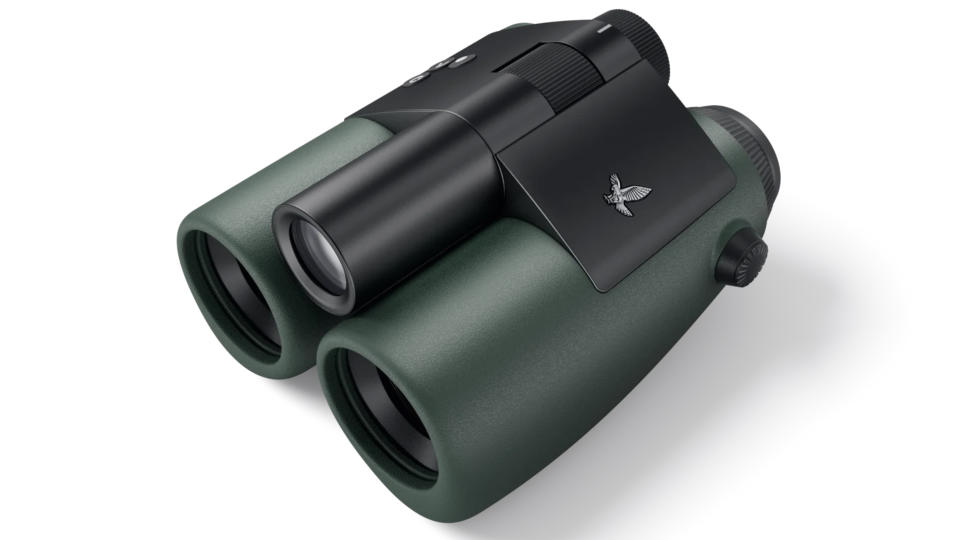
The AX Visio’s onboard camera is housed within a narrow barrel just in front of the main function selector. The camera features a 13 megapixel sensor capable of shooting both 13mp stills and video up to 1080p video.
However, it’s very important to note that the camera’s magnification is at least half of what you see through the binoculars so don’t expect the sort of in-your-face subject detail that you get through the binocular lenses. The camera lens is apparently 265mm while the binoculars are nearer 500mm. That’s a big disparity but one that’s easily explained because to make the lenses any more powerful would have meant a much larger camera and a heavier housing to take the focal length to anywhere near 500mm. It would also require some form of image stabilisation to prevent out-of-focus images. In Swarovski’s favour, the company has opted for the best camera magnification possible without increased size, weight and camera shakiness.
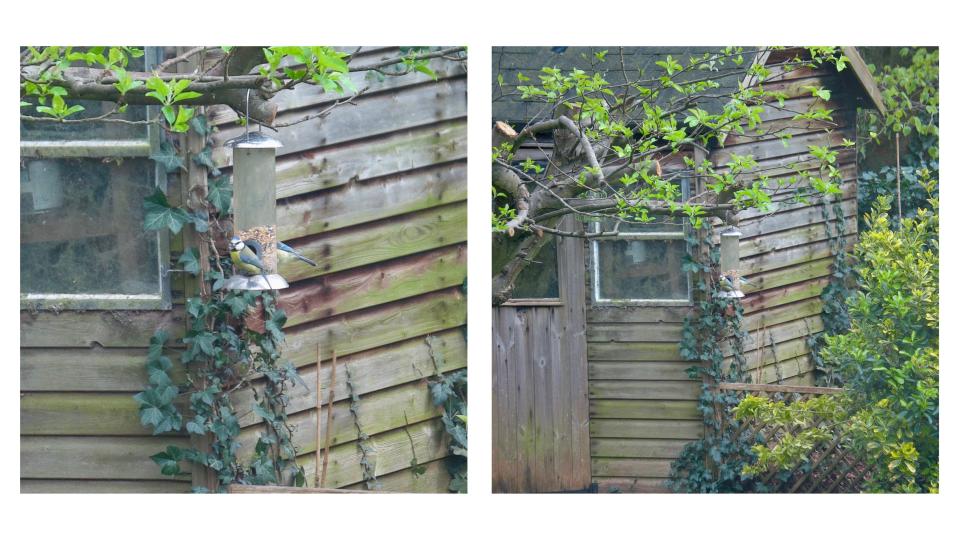
As a consequence of camera and lens size restrictions, image quality from the camera isn't especially sharp unless the binoculars are supported on a branch or ledge, or the subject is less than say, 50 metres away. But more than that – and understandably so – the images are in no way comparable with a long-range camera like the phenomenal Sony RX10 and its ultra-long 600mm lens, which produces stunning shots from a much longer distance. In other words, this isn't the camera to use if you want high-resolution presentation stills or video.
On the other hand, I can still see the Swarovski camera being a very handy feature because the images can be easily downloaded to the accompanying app as proof of your bird- or mammal-spotting prowess, along with all the animal identification data. Think of the camera as an added bonus to all the other onboard smarts, but not a sole reason to buy it.
On the plus side, you can tweak the camera's settings like exposure compensation (highly recommended), brightness and colour saturation in the app to get the most out of it and then save the parameters.
Swarovski AX Visio review: the app
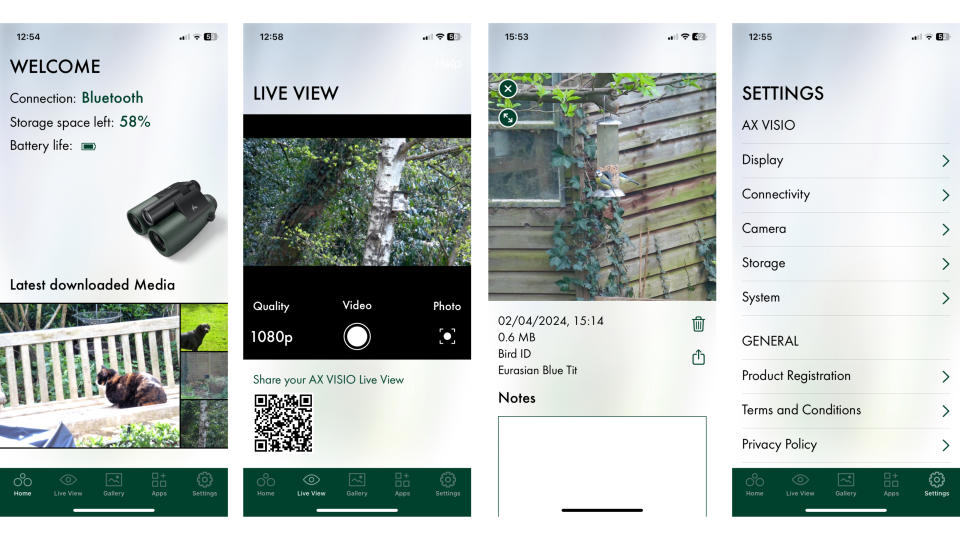
To get the most out of this product you should download the accompanying ‘SO Outdoor’ app. Although it can occasionally take a while for the app to sync to the binoculars, I’ve been mostly impressed with the interface which is divided into four main sections – Home, Live View, Gallery and Settings.
Home is basically a general overview of remaining battery percentage with the provision to download images and video to your phone’s image library. Live View is for companions to see what you’re looking at through the binoculars, Gallery is where all your images and video are stored within the app and Settings is where you adjust various parameters in the binoculars like display brightness, duration and text size.
There’s also a storage settings option but all it tells you in the amount of available storage space. I have not found a way to format erase the AX Visio’s onboard storage so I can only presume that storage is overwritten when near full. The AX Visio comes with 32GB of storage but around 11.8GB of that is devoted to the system.
Swarovski AX Visio review: verdict
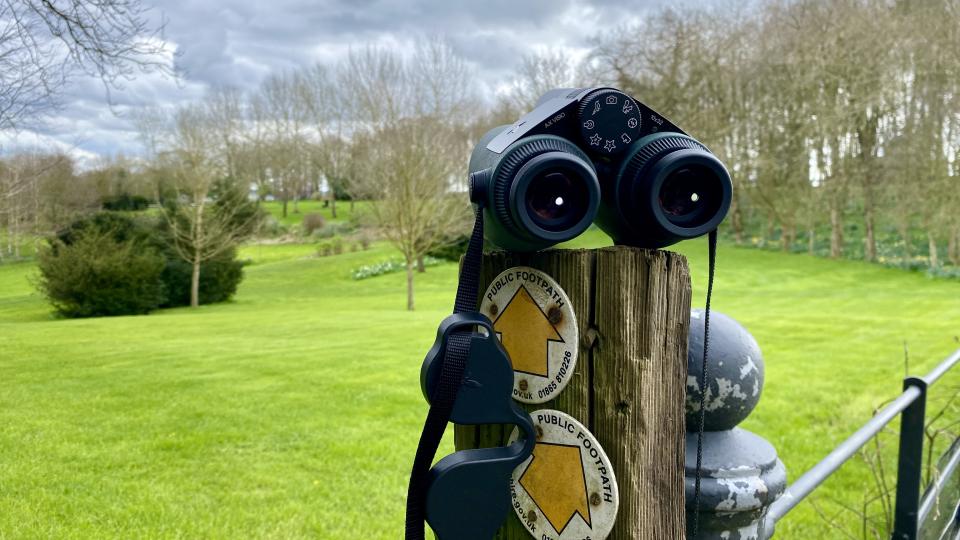
Although this is a pretty niche—and very, very expensive—product, I’ve been very impressed with the Swarovski AX Visio, at least from a smarts point of view. Yes, the camera is understandably a bit of a weak spot, but there’s no denying the usefulness of its bird and mammal identification function. Figure in the product’s impeccable optics and the innovative and genuinely brilliant ‘Share Discoveries’ function, and you have the most complete set of binocular features ever created.

